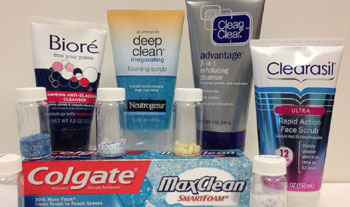Plastic microbeads are fairly new in personal care products, but in the short time they’ve been on the market, they have caused serious water pollution problems.
These tiny plastic beads – barely visible without a microscope – are 0.5-5 millimeters in diameter, and can be found in products from toothpaste to soap and cosmetics. Too small to be filtered by water treatment plants, they go down the drain and directly into waterways, with billions ending up in rivers, lakes, and the ocean. There, they are swallowed by small fish (they are the size of zooplankton), entering the food chain and ending up in humans.
They also tend
to attract motor oils and pesticides, adding more toxins to the food
chain.
Commonly found in ocean samples, microbeads are at equally high concentrations in the Great Lakes – 1,500 to 1.7 million plastic particles per square mile – say researchers at University of Wisconsin/ Superior. Lake Erie is the worst,
containing over 90% of plastics found, finds 5 Gyres Institute.
In a rare move, manufacturers are responding to the data rather than resisting it. Unilever, Procter & Gamble, Johnson & Johnson, L’Oreal, The Body Shop and Colgate-Palmolive have already stopped using microbeads or say they are phasing them out. One of the reasons is that – as anyone that buys organic products knows – natural substitutes are readily available.

Illinois banned microbeads with almost no industry opposition, and bills are moving forward in New York and California. Once manufacturers reformulate products for those major markets, microbeads will disappear (if not from our waters). On the federal level, Rep. Frank Pallone (D-NJ) introduced the Microbead-Free Waters Act of 2014, which would ban the sale or distribution of products containing microbeads in 2018.
If you buy conventional personal care products, look for "microbeads," "polyethelene," or "polypropylene" on the label.
We’ve known for years about the dead zones plastics are causing in the world’s ocean, but microbeads were discovered just a couple of years ago when scientists sampled all the Great Lakes with custom designed nets. They found them everywhere.
Incredibly, more than a trillion micro-plastics could be released into the ocean over the next 10 years because of the melting Arctic. Researchers actually found high concentrations trapped in ice cores, reported in "Global Warming Releases Microplastic Legacy Frozen in Arctic Sea Ice." Besides microbeads, they come from semi-synthetic fibers like rayon (from washing machines) and the breakdown of larger plastics.
There’s even stone infused with plastic now, found on the beach in Hawaii and officially named Plastiglomerate by the Geological Society of America. "Our results indicate this anthropogenically influenced material has great potential to form a marker of human pollution, signaling the occurrence of the informal Anthropocene epoch."
Read more about plastiglomerate in the NY Times:

 Loading...
Loading...
if you think plastic bags might not be good for sea turtles, imagine the digestive tracts of bazillions of tiny critters, ie the base of the food chain, all gummed up and either dead & unavailable to fish and other consumers in the food chain, or passsing the goo on up to concentrate at higher levels. Like in us.
We are drinking these microscopic particles if they are in the Great Lakes. Do they lodge in the body? Can they be detected in the body? Who manufactures theses particles? Please stop!